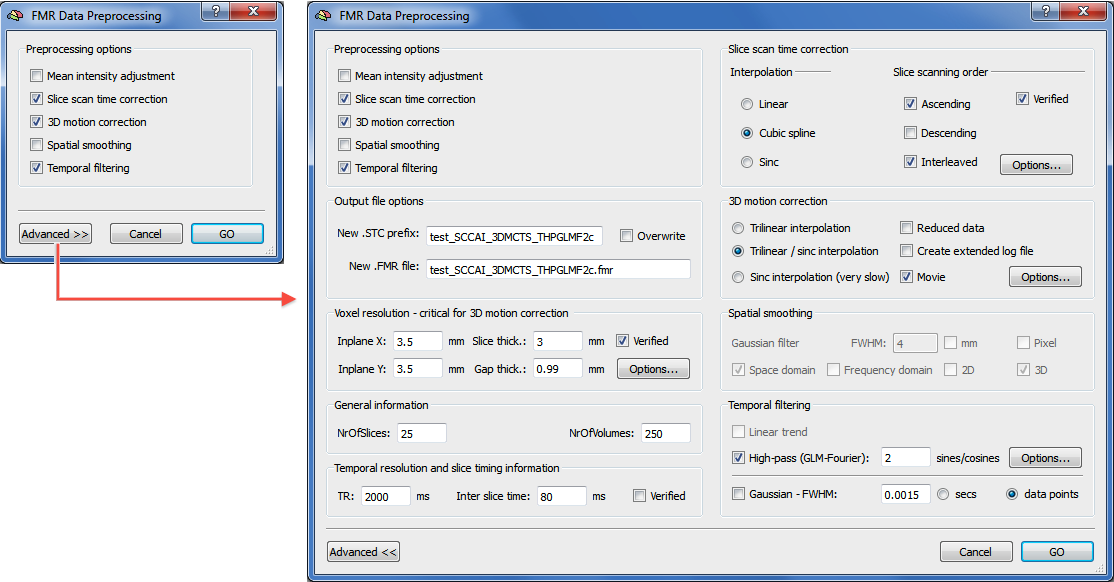BrainVoyager v23.0
Overview of Functional Preprocessing
In order to reduce artifact and noise-related signal components, a series of operations is typically performed on raw functional data sets prior to statistical analysis. The most essential steps of these preprocessing operations are:
- Removal of global signal fluctuations
- Slice scan timing correction
- Head motion detection and correction
- Removal of linear and non-linear trends
- Spatial and temporal smoothing

In BrainVoyager, preprocessing steps are available for FMR projects in the FMR Data Preprocessing dialog that can be invoked by using the Analysis > FMR Data Preprocessing menu. The snapshots above show the dialog in its two forms. On the left side the initial version of the dialog is shown allowing to turn on or off preprocessing steps that will be executed using default settings; the preprocessing routines for Slice scan time correction, 3D motion correction and Temporal filtering are selected as default. Clicking the Advanced button opens the extended version of the dialog that allows more fine-grained control of preprocessing parameters. Note that preprocessing usually does not overwrite the original data but produces a new set of files with names that reflect the performed preprocessing options as shown in the Output file options field. When one really wants to overwrite the input data (not recommended), the Overwrite option can be used. Keeping multiple data sets with different preprocessing options allows easy comparison of their effects for statistical analysis.
The General information field displays the number of slices (NrOfSlices) and number of time points (NrOfVolumes) of the current FMR project; these fundamental characteristics of an FMR project can not be changed. The Voxel resolution field shows the assumed values for the inplane size of voxels as well as the slice thickness that are usually extracted from original image files when creating the project. If the Verified option is not turned on, one must check and probably modify these values; note that motion correction will only work correctly if these values describe the data correctly. The Temporal resolution and slice timing information field shows the assumed values for the temporal resolution (TR) of the performed functional scan (time between successively recorded volumes) and the time required to scan a single slice (Inter slice time) that is usually (but not always!) equal to TR / NrOfSlices. These values may not always be extracted from the original data files and it is recommended to check them carefully. If one is confident that the (entered) values are correct, one should check the Verified option; note that slice scan time correction will only work correctly if these values describe the data correctly.
Some Recommendations
While motion correction and slice scan time correction can only be performed for FMR projects, some preprocessing steps are also available for VTC projects that are created after spatial normalization, i.e. after creation of functional volume time courses in a known 3D space, such as native (space of a measured VMR data set), ACPC or Talairach space. Since VTC preprocessing includes 3D spatial smoothing and temporal filtering/smoothing, it is not necessary to apply these steps to the original FMR space which would require to repeat the (rather slow) VTC creation process. To retain flexibility and to minimize work load, we thus recommend to:
- Perform motion correction, slice scan time correction, high pass filtering (and MIA) in FMR space, but no spatial and temporal smoothing.
- Create VTC pendant for each FMR data set. Add smoothing as desired, e.g. little (4mm FWHM) or no spatial smoothing for single-subject analyses and cortex-based group analyses, and modest smoothing (8mm FWHM) for Talairach space group analyses.
Note that the appliation of preprocessing steps (for FMR and VTC projects) can be easily performed using scripts (see x) that are especially useful if a fMRI experiment involves many runs from multiple subjects. If one decides to re-un preprocessing in FMR space with different settings, the generation of corresponding VTC files can also be scripted.
Copyright © 2023 Rainer Goebel. All rights reserved.